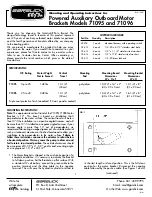
P3V Veterinary Digital Ultrasonic Diagnostic Imaging System User Manual
- 24
-
4.3.5. Equipotential Bonding
Figure 4-8 Equipotential Bonding
Any use of other devices with the system is at the user’s risk and may void the system warranty.
In order to fulfill IEC/EN 60601-1-1 requirements, connections of peripheral equipment to the
P3V must adhere to one of the following conditions:
The peripheral equipment itself is a medical device approved according to IEC/EN 60601-1.
Non-medical peripheral equipment approved according to any other EN or IEC standard
must use the following setup for connection:
➢
Connect the equipotential connector of P3V to an independent protective earth terminal
with a potential equalization conductor.
➢
The peripheral equipment is located at least 1.5 meters (1.8 meters in Canada and the
U.S.A) outside the patient environment. A patient environment is defined as the area in
which medical examination, monitoring, or treatment of the patient takes place.
➢
The peripheral equipment is connected to a main outlet outside the patient environment
but still within the same room as the ultrasound system.
WARNING
1. Equipotential bonding: when the device is running with other instruments jointly,
consideration should be given to equipotentiality.
2. Doctors and patients might be exposed to the hazardous and uncontrollable effects of
compensating current caused by unbalanced equipotentiality between indoor medical
device and touchable conducting parts. The safest solution is to build a unified
equipotential network, to which the medical device is connected, using an angular
plug.
Equipotential terminal Rear panel Potential equalization conductor
Equipotential terminal Another device
















































